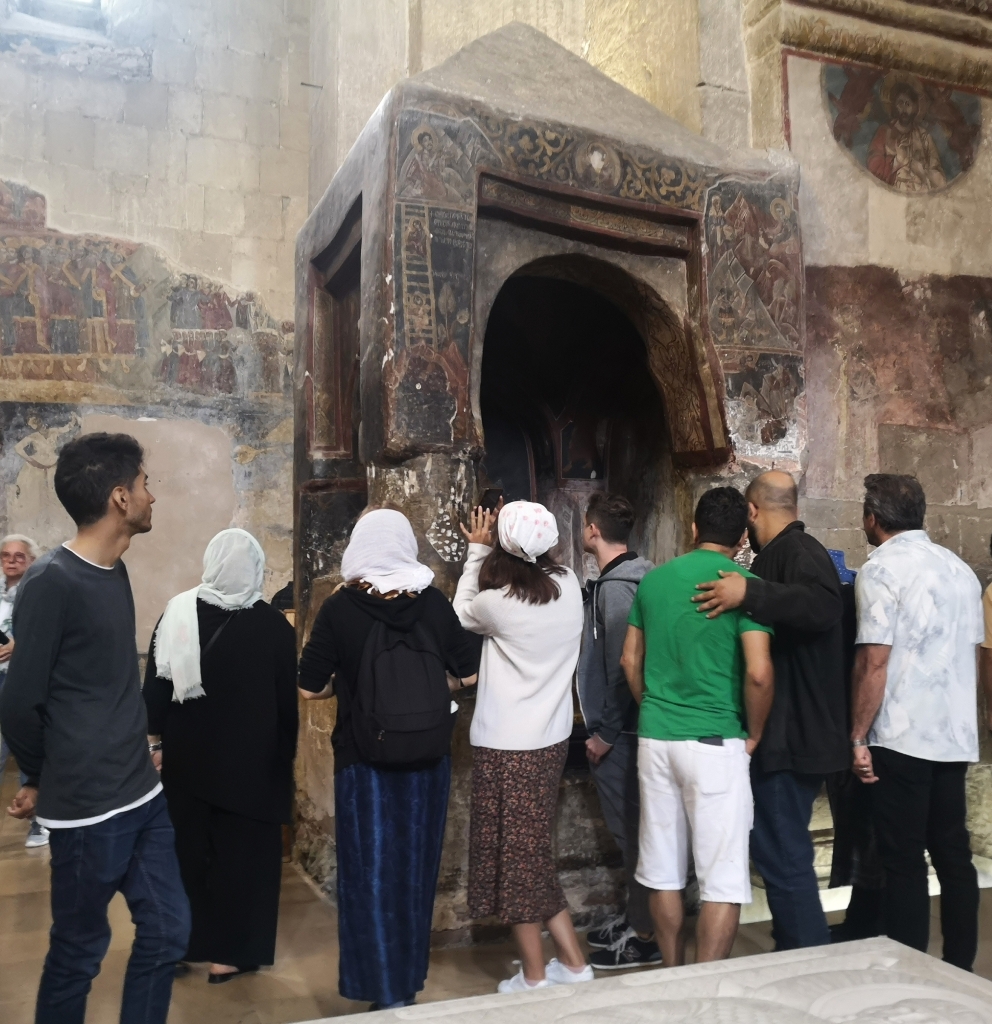St Sidonia’s healing tree

Yesterday, Epiphany, Twelfth Night, was the end of the line for the tree which has kept us glittering company during the darkest days of winter. Since then it has been stripped of its ornaments (an historic collection, accumulated over the years of our family’s growth) and dragged out into the cold, leaving a memorial trail of stabbing needles across the carpet, to await dismemberment.
Every year I feel guilty about this, as if betraying the trust of a guest. It reminds me of the autumn slaughter of the family pig, almost a pet, which has lived close to the house and shared our food, its dying squeals an essential component of any film set in the rural past. (We haven’t got one, by the way…)

More on trees, or at least one remarkable trees, from geomantic Mtskheta, at the confluence of the Mtkvari and Aragvi Rivers.

I was fascinated when I first set eyes on this icon since it reminded me of an image I’d seen long ago of a tree springing from the grave of Adam (a brown skeleton tangled in its roots), soaring up until, in its very crown, hung the crucified Christ. I’ve looked for this image. I knew exactly where it was; I searched out the book, flicked through, turned the pages more carefully…and, mysteriously, it isn’t there. However, I’ve come across similar accounts of this tradition, with various tree species named. That below brings in our friend Mithras as well.
https://aras.org/concordance/content/tree-life-and-tree-death
A Georgian, Elioz, witnessed The Crucifixion, after which he bartered with the Roman soldiers for Christ’s robe. Upon his return, he presented this holiest of relics to his sister, Sidonia, who swooned with emotion and died on the spot. The sacred garment was so tightly locked in her embrace that it could not be prised away and had to be buried with her and from her grave there rose a miraculous Cypress.
“At the beginning of the fourth century, the holy virgin Nino arrived in Kartli to preach the Christian Faith, settling in the outskirts of Mtskheta, in the bramble bushes of the king’s garden. St. Nino inquired as to the whereabouts of our Lord’s Robe, but no one could remember where it had been preserved. In her quest for the Precious Robe, she became acquainted with Elioz’s descendants, the Jewish priest Abiatar and his daughter, Sidonia. St. Nino converted them to Christianity.
St. Nino was blessed by God with the gift of healing. She healed the afflicted through the name of the Saviour and through the grace of the cross formed from grapevines by the Virgin Mary and bound with strands of St. Nino’s hair.”
What’s interesting and different at Mtskheta is that when, on Saturday, June 24, 324, King Mirian, with the blessing of St Nino, to build a cathedral on this sacred site, the initial materials to be furnished by the miraculous tree itself.
“Seven columns to support the church were formed from the wood of a cypress tree that had grown in the king’s garden. Six of the columns were erected without problems, but the seventh could not be moved from the place where it had been carved. St. Nino and her disciples prayed through the night, and at dawn they watched as a youth, encompassed by a brilliant light, descended from the heavens and raised the column. The miraculous column began to shine and stopped in mid-air at a height of twelve cubits. Sweet-smelling myrrh began to flow from under the Holy Pillar’s foundations, and the entire population of Mtskheta flocked to that place to receive its blessing. Approaching the Life-giving Pillar, the sick were healed, the blind received sight, and the paralyzed began to walk.

The robe is said still to be housed here within the cathedral and I suppose the Svetitskhoveli too, if no longer in mid-air. When I asked our guide whether any investigations had been carried out to ascertain the state of these relics, she looked amazed that I could even think of such a thing; faith should suffice.


And back to Christmas Trees, a tradition that we owe to St Boniface. Or maybe not so much a tradition as cultural appropriation:
“Boniface knew that in winter the inhabitants of the village of Geismar gathered around a huge old oak tree (known as the “Thunder Oak”) dedicated to the god Thor. This annual event of worship centered on sacrificing a human, usually a small child, to the pagan god. Boniface desired to convert the village by destroying the Thunder Oak, which the pagans had previously boasted the God of Boniface could not destroy, so he gathered a few companions and journeyed to Geismar.
His fellow missionaries were scared and fearful that the Germans might kill them, so they balked when they reached the outskirts of the village on Christmas Eve. Boniface steadied the nerves of his friends and as they approached the pagan gathering he said, “Here is the Thunder Oak; and here the cross of Christ shall break the hammer of the false god Thor.” Boniface and his friends arrived at the time of the sacrifice, which was interrupted by their presence. In a show of great trust in God and born from a desire to enkindle the fire of Christ in the German pagans, Boniface grabbed an axe and chopped down the Thunder Oak of mighty Thor.
The Germans were astounded. The holy bishop preached the Gospel to the people and used a little fir tree that was behind the now felled oak tree as a tool of evangelization. Pointing to it he said,
“This little tree, a young child of the forest, shall be your holy tree tonight. It is the wood of peace… It is the sign of an endless life, for its leaves are ever green. See how it points upward to heaven. Let this be called the tree of the Christ-child; gather about it, not in the wild wood, but in your own homes; there it will shelter no deeds of blood, but loving gifts and rites of kindness.”
Awed by the destruction of the oak tree and Boniface’s preaching, the Germans were baptized.”


And back to Georgian food……… “What,” I hear you say, “has all this got to do with birds? Or RXland?”

I have other interests, though not enough time to write about them. And, as I have commented in the past, it can get a bit repetitive just writing about birds.

The internet is just now creaking under the weight of near-identical Waxwing photos. Before that it was Short-eared Owls, before that Kingfishers…



January 7, 2024 at 22:27
That all looks delicious – and a change from birds for a post or two!
January 9, 2024 at 03:11
It’s good to be back in touch with you Ursula. Best wishes for 2024!